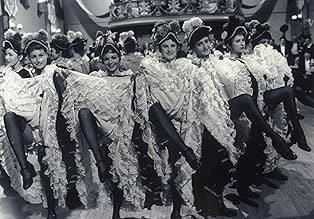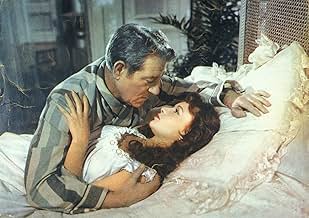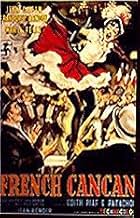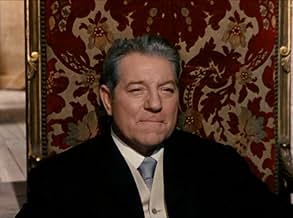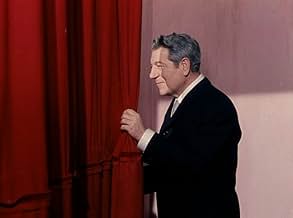AVALIAÇÃO DA IMDb
7,3/10
4,7 mil
SUA AVALIAÇÃO
Adicionar um enredo no seu idiomaThis comedy drama from Jean Renoir chronicles the revival of Paris' most notorious dance as it tells the story of a theater producer who turns a humble washerwoman into a star at the Moulin ... Ler tudoThis comedy drama from Jean Renoir chronicles the revival of Paris' most notorious dance as it tells the story of a theater producer who turns a humble washerwoman into a star at the Moulin Rouge.This comedy drama from Jean Renoir chronicles the revival of Paris' most notorious dance as it tells the story of a theater producer who turns a humble washerwoman into a star at the Moulin Rouge.
- Direção
- Roteiristas
- Artistas
- Direção
- Roteiristas
- Elenco e equipe completos
- Produção, bilheteria e muito mais no IMDbPro
Avaliações em destaque
Although it doesn't seem very promising for a long stretch, Renoir's French Cancan ends up being an effortlessly charming film. The story is cliché: a laundry girl, Nini (Françoise Arnoul), is discovered by a night club owner, Danglard (Jean Gabin). Danglard steals her from her baker boyfriend and drops his current girlfriend, both of whom come back for their former lovers. Nini has to choose whether to go back to her humble life with the baker, go on with the show with her employer, oh, or become a princess, as a prince falls in love with her at one point, too. I'm glad the film didn't go for the most obvious choice, as a lesser film certainly would have. The film ends with the opening of Danglard's new night club, the Moulin Rouge, and a couple of gorgeous song and dance numbers. The first of them, "Complainte de la Butte," which also provides the base of most of the film's musical score, is simply one of the most gorgeous songs ever written, and Renoir himself wrote it. If you're a fan of Baz Luhrmann's 2001 film Moulin Rouge!, you'll recognize the tune, as it comes up near the beginning of that film, sung by Rufus Wainwright. Although it isn't very prominent in that film, everyone I know who owns the soundtrack loves it. In addition to having one of the most lovely songs ever written, French Cancan also boasts one of the cutest leading ladies ever to grace the screen. It's hard not to fall head-over-heels in love with that girl. 8/10.
Portrait of a time. portrait of a legend. seductive for the genius of Jean Renoir. and for the inspired performances. and, sure, for the nostalgia of the viewer. an admirable Jean Gabin and a great embroidery of love stories, show world, rivalries and triumph. optimistic, romantic. and refreshing. and that does to it a special status. like refuge, splendid show, fairy tale and confession of a lost age.
10bob998
This is my favorite Renoir from the Fifties. It's the story of how Henri Danglard built and launched the Moulin Rouge nightclub; we see the workmen blasting at the site to get construction underway, and the training of the dancers. Finally, the giddiness of opening night and the long sequence of cancan dancing. Financial problems and the ego displays of the performers are described.
Gabin is in great form as the easy-going Danglard--see him deal humorously with Nini's violent boyfriend. Gianni Esposito is moving as the wistful Prince who is courting Nini. Maria Felix, with that amazon's body, is imposing as the egotistical Lola, Danglard's first lover. Finally Françoise Arnoul as Nini the washing girl who ends up dancing for Danglard, and becoming his girl, is just stunning; her loveliness and pert charm will win you over.
A bonus: we get Edith Piaf, Patachou, André Claveau and other stars in cameos playing the stars of a century ago who ruled over the Moulin rouge.
Gabin is in great form as the easy-going Danglard--see him deal humorously with Nini's violent boyfriend. Gianni Esposito is moving as the wistful Prince who is courting Nini. Maria Felix, with that amazon's body, is imposing as the egotistical Lola, Danglard's first lover. Finally Françoise Arnoul as Nini the washing girl who ends up dancing for Danglard, and becoming his girl, is just stunning; her loveliness and pert charm will win you over.
A bonus: we get Edith Piaf, Patachou, André Claveau and other stars in cameos playing the stars of a century ago who ruled over the Moulin rouge.
A charmingly amoral club owner sets his sights — amorous and financial — on a beautiful, naïve blue collar girl and propels her to the height of celebrity thanks to her titillating dance skills.
It may sound like a contemporary, cutting edge urban drama, but French Cancan was made in 1956 by famed director Jean Renoir. The movie — a darkish comedy with a progressive take on sexuality — chronicles the birth of the Moulin Rouge. Legendary Jean Gabin plays Danglard, a world-weary hustler, club owner and anti-hero for the ages, who makes no pretense of his philandering and amorous proclivities. He's casting about for a new lover and a new money making venture when his current club fails and he grows bored with his mistress. He discovers a beautiful young washer girl, Nini, whom he convinces to headline at his new "concept" club, the Moulin Rouge, making it a hot spot and her a celebrity before the doors even open.
It doesn't hurt that Nini's moody ex-lover — a sullen baker (le petit grump) — injures Danglard in a fight and an even moodier Russian count becomes suicidal because Nini spurns his advances. As the salacious headlines drive up public interest, they learn the club will feature the cancan in all it's thigh-revealing, petticoat-flashing, bawdy glory — a disreputable dance to begin with now fallen completely out of favor.
The movie is a riot with memorable characters, beautiful, dizzying club and dance scenes, a few titillating moments that must have pushed the limits 60 years ago and swooning French girls forever throwing themselves desperately into and out of the arms of their lovers. You almost forget that it's a musical, so seamlessly are the musical and dance scenes integrated into the plot.
Danglard's gangly side kick is hilarious as is the whistler. Most delightful of all was seeing and hearing the divine Edith Piaf on screen after listening in awe to her songs all these years.
The movie is best enjoyed with absinthe in honor of the absinthe consumed on screen — as fate would have it, we had some delightful Oregon-made absinthe that night — or lots of champagne.
-- www.cowboyandvampire.com --
It may sound like a contemporary, cutting edge urban drama, but French Cancan was made in 1956 by famed director Jean Renoir. The movie — a darkish comedy with a progressive take on sexuality — chronicles the birth of the Moulin Rouge. Legendary Jean Gabin plays Danglard, a world-weary hustler, club owner and anti-hero for the ages, who makes no pretense of his philandering and amorous proclivities. He's casting about for a new lover and a new money making venture when his current club fails and he grows bored with his mistress. He discovers a beautiful young washer girl, Nini, whom he convinces to headline at his new "concept" club, the Moulin Rouge, making it a hot spot and her a celebrity before the doors even open.
It doesn't hurt that Nini's moody ex-lover — a sullen baker (le petit grump) — injures Danglard in a fight and an even moodier Russian count becomes suicidal because Nini spurns his advances. As the salacious headlines drive up public interest, they learn the club will feature the cancan in all it's thigh-revealing, petticoat-flashing, bawdy glory — a disreputable dance to begin with now fallen completely out of favor.
The movie is a riot with memorable characters, beautiful, dizzying club and dance scenes, a few titillating moments that must have pushed the limits 60 years ago and swooning French girls forever throwing themselves desperately into and out of the arms of their lovers. You almost forget that it's a musical, so seamlessly are the musical and dance scenes integrated into the plot.
Danglard's gangly side kick is hilarious as is the whistler. Most delightful of all was seeing and hearing the divine Edith Piaf on screen after listening in awe to her songs all these years.
The movie is best enjoyed with absinthe in honor of the absinthe consumed on screen — as fate would have it, we had some delightful Oregon-made absinthe that night — or lots of champagne.
-- www.cowboyandvampire.com --
Of the several Jean Renoir films I have seen, this was by far the most interesting.
This film was obviously the inspiration for the Baz Luhrman film Moulin Rouge. Luhrman even appropriated one of the original songs for use in his film.
The film tells the story of the construction of the Moulin Rouge for the presentation of a revival of the CanCan. Although characterization is a bit weak and most characters are little more than stereotypes, the plot, music, action, and spectacular visuals more than make up for the shortcomings.
This is a loving tribute to the Paris of the impressionist period and is filmed beautifully in color.
Does anyone know if there is any truth to the tale?
This film was obviously the inspiration for the Baz Luhrman film Moulin Rouge. Luhrman even appropriated one of the original songs for use in his film.
The film tells the story of the construction of the Moulin Rouge for the presentation of a revival of the CanCan. Although characterization is a bit weak and most characters are little more than stereotypes, the plot, music, action, and spectacular visuals more than make up for the shortcomings.
This is a loving tribute to the Paris of the impressionist period and is filmed beautifully in color.
Does anyone know if there is any truth to the tale?
Você sabia?
- CuriosidadesThe on-screen singer of "La complainte de la Butte" is not Cora Vaucaire (credited in the titles) as she was deemed not good-looking enough to appear on film, so Italian actress Anna Amendola was put in front of the camera and mimed to the song...
- Citações
Henri Danglard: Do I look like Prince Charming? Only one thing matters to me - what I create.
- Versões alternativasOriginally released in the US in 1956 at 93 minutes; ten minutes of footage removed from the original French version were reinstated for 1985 reissue.
- ConexõesFeatured in Viagem Através do Cinema Francês (2016)
Principais escolhas
Faça login para avaliar e ver a lista de recomendações personalizadas
- How long is French Cancan?Fornecido pela Alexa
Detalhes
Bilheteria
- Faturamento bruto mundial
- US$ 10.799
- Tempo de duração1 hora 42 minutos
- Cor
Contribua para esta página
Sugerir uma alteração ou adicionar conteúdo ausente

Principal brecha
By what name was French Can Can (1955) officially released in India in English?
Responda
![Assistir a Bande-annonce [VO]](https://m.media-amazon.com/images/M/MV5BMDIzNTViZDUtMTQ0MC00MDExLWFkNzYtNjJhMDlkN2YzMDRjXkEyXkFqcGdeQXRyYW5zY29kZS13b3JrZmxvdw@@._V1_QL75_UX500_CR0)
